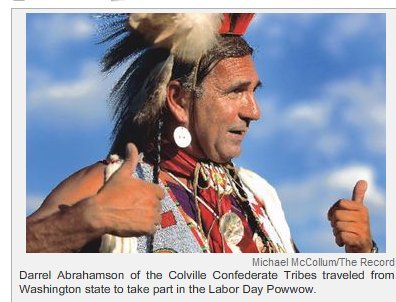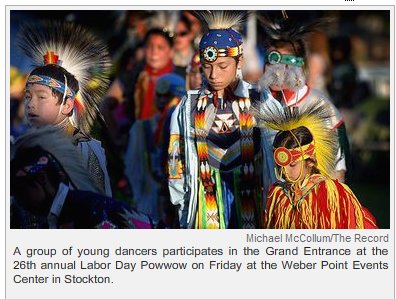

In spirit of preservation
American Indians maintain cultural traditions with annual powwow
By Jennifer Torres


In
spirit of preservation
American
Indians maintain cultural traditions with annual powwow
By
Jennifer
Torres
September 01, 2007
Record Staff Writer
STOCKTON - Mothers braided their daughters' long ponytails along the edges of the sacred circle Friday as bells jangled and drums began to beat.
David Wilson Jr. and Steven Bojorques used to watch their fathers organize community powwows like this one as a means of preserving and sharing American Indian culture. Now they plan them.
Earlier this week, the men sat at the head of a table reviewing details of the 26th annual Labor Day Powwow, which continues today and Sunday at the Weber Point Events Center.
"For me, it was always about the culture," Bojorques said. "I just don't want this to die."
According to U.S. Census Bureau statistics, 5,801 San Joaquin County residents are American Indians or native Alaskans. Another 6,226 claim at least some American Indian ancestry.
Both figures have increased over the past five years. Still, American Indians account for a relatively small portion of the county's overall population - a little less than 2 percent.
Maintaining American Indian traditions demands respect for the past, Bojorques said.
"We listen always to our elders," he said. "Basically, it's passed down through our children, our culture."
Events such as the powwow enable that reverence for history and attention toward the future, Wilson said.
"It's about being one with the Creator," he said. "That's one of the main reasons I do this."
At the powwow Friday, Ikoshy Montoya, a Lipan Apache, set up a booth of his airbrush paintings, many depicting American Indian creation stories. He calls himself an "urban Indian."
"I wasn't raised traditionally," he said. But at powwows, he said, he can connect with other members of American Indian nations. He believes the events are also important for American Indian children.
"They go to sleep hearing the music," he said. "What we're doing for them is creating a foundation. By doing that, we keep our nation strong."
According to focus group research released this week from the nonprofit Public Agenda organization, many American Indians believe that non-Indians have formed perceptions of them that are based on inaccurate stereotypes.
Non-Indians, meanwhile, reported that they know little about the modern American Indian community.
"The results suggest that, compared with other minorities, Indians living away from reservations are largely invisible to most non-Indians," the report's authors concluded.
Dale Fleming, an American Indian specialist for the Stockton Unified School District, said the annual powwow can be a vehicle for understanding and education.
"We get to share," Fleming said. "We want the non-Indians there."
Contact reporter Jennifer Torres at (209) 546-8252 or jtorres@recordnet.com.